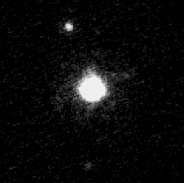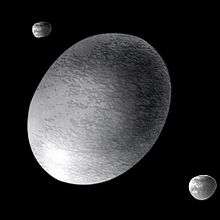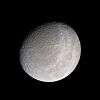Hiʻiaka (moon)
|
Hiʻiaka is above Haumea (center) in this Keck telescope image. | |
| Discovery | |
|---|---|
| Discovered by |
Michael E. Brown, Chad Trujillo, David Rabinowitz, et al. |
| Discovery date | 26 January 2005 |
| Designations | |
| MPC designation | Haumea I Hiʻiaka |
| Pronunciation | /ˌhiːʔiˈɑːkə/[1] |
|
(136108) 2003 EL61 I, S/2005 (2003 EL61) 1 | |
| Orbital characteristics[2] | |
| 49880±198 km | |
| Eccentricity | 0.0513±0.0078 |
| 49.12±0.03 d | |
| Inclination | 126.356±0.064° |
| Satellite of | Haumea |
| Physical characteristics | |
Mean radius | ~160 km[2] |
| Mass | (1.79±0.11)×1019 kg[2] (0.45% of Haumea) |
Mean density | ~1 g/cm3 |
| Temperature | 32±3 K |
| 3.3 difference from primary's 17.3 | |
|
| |
Hiʻiaka is the larger, outer moon of the dwarf planet Haumea.
Discovery and naming
Hiʻiaka was the first satellite discovered around Haumea. It is named after one of the daughters of Haumea, Hiʻiaka, the patron goddess of the Big Island of Hawaii, though at first it had gone by the nickname "Rudolph" by its discovery team. It orbits once every 49.12±0.03 d at a distance of 49880±198 km, with an eccentricity of 0.0513±0.0078 and an inclination of 126.356±0.064°. Mutual events expected in July 2009 should improve the knowledge of the orbits and masses of the components of the Haumean system.[2]
Physical characteristics
Size and brightness
Its measured brightness is 5.9±0.5%, translating into a diameter of about 22% of its primary, or in the range of 320 km, assuming similar albedo.[2] To put this in perspective, this would make it larger than all but four of the asteroids, after 1 Ceres, 2 Pallas, 4 Vesta, and 10 Hygiea. In spite of its relatively large size, however, lightcurve studies suggest that Hi'iaka is not a gravitationally collapsed spheroid; they further suggest that Hi'iaka is not tidally locked and has a rotation period of about 9.8 hours. [3]
Mass
The mass of Hiʻiaka is estimated to be (1.79±0.11)×1019 kg using precise relative astrometry from Hubble Telescope and Keck Telescope and applying 3-body, point-mass model to the Haumean system.[2]
Spectrum and composition
The near infrared spectrum of Hiʻiaka is dominated by water-ice absorption bands, which means that its surface is made mainly of water ice. The presence of the band centered at 1.65 µm indicates that the surface water ice is primarily in the crystalline form. Currently it is unclear why water ice on the surface has not turned into amorphous form as would be expected due to its constant irradiation by cosmic rays.[4]
See also
References
- ↑ The Hawaiian pronunciation is [ˈhiʔiˈjɐkə].
- 1 2 3 4 5 6 Ragozzine, D.; Brown, M. E. (2009). "Orbits and Masses of the Satellites of the Dwarf Planet Haumea (2003 EL61)". The Astronomical Journal. 137 (6): 4766. arXiv:0903.4213
 . Bibcode:2009AJ....137.4766R. doi:10.1088/0004-6256/137/6/4766.
. Bibcode:2009AJ....137.4766R. doi:10.1088/0004-6256/137/6/4766.
- ↑ http://www.planetary.org/blogs/guest-blogs/2016/1017-rapidly-rotating-regular-satellites-and-tides.html
- ↑ Dumas, C.; Carry, B.; Hestroffer, D.; Merlin, F. (2011). "High-contrast observations of (136108) Haumea". Astronomy & Astrophysics. 528: A105. arXiv:1101.2102
 . Bibcode:2011A&A...528A.105D. doi:10.1051/0004-6361/201015011.
. Bibcode:2011A&A...528A.105D. doi:10.1051/0004-6361/201015011.


